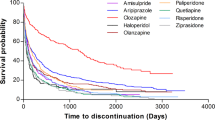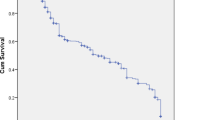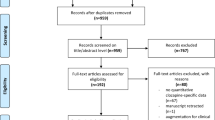Abstract
Antipsychotic drugs can inhibit the effects of phencyclidine (PCP) and d-amphetamine (AMPH) in many rodent tests, but the effects are usually seen at doses that also affect vehicle-treated control rats, suggesting that the inhibition may be nonspecific. This study will attempt to test the predictive validity of these models based on the clinical observations that antipsychotics are not fully effective until after 2–3 weeks of administration in patients and that patients do not relapse immediately following abrupt withdrawal of medication. Haloperidol and clozapine were tested in rats after daily administration for 3 and 21 days in combination with vehicle or PCP (2.0 mg/kg) in the social interaction test, and with vehicle or AMPH (0.5 mg/kg) in standard activity cages. To separate acute from more long-lasting effects on the central nervous system (CNS) haloperidol and clozapine were tested with a short (45 or 30 min depending upon test) and a long (22–24 h) pretreatment time. The results demonstrated that haloperidol and clozapine following both 3 and 21 days of administration at the short pretreatment time inhibited the activity of vehicle-, PCP-, and AMPH-treated rats, whereas neither drug had consistent effects in any group at the long pre-treatment time. The data suggest that antipsychotics only inhibit PCP- and AMPH-induced behaviors in rodents by an acute drug-drug interaction, whereas any long-term effects of antipsychotic drug administration on the CNS cannot be revealed by PCP and AMPH in rodents.
Similar content being viewed by others
Log in or create a free account to read this content
Gain free access to this article, as well as selected content from this journal and more on nature.com
or
References
Angist B, Lee HK, Gershon S . (1974): The antagonism of amphetamine-induced symptomatology by a neuroleptic. Am J Psychiatry 131: 817–819
Arnt J . (1995): Differential effects of classical and newer antipsychotics on the hypermotility induced by two levels of D-amphetamine. Eur J Pharmacol 283: 55–62
Baldessarini RJ, Centorrino F, Flood JG, Volpicelli SA, Huston-Lyon D, Cohen BM . (1993): Tissue concentrations of clozapine and its metabolites in the rat. Psychopharmacology 9: 117–124
Borison RL, Diamond BI, Sinha D, Gupta RP, Ajiboye PA . (1988): Clozapine withdrawal rebound psychosis. Psychopharmacol Bull 24: 260–263.
Breier A, Buchanan RW, Kirkpatrick B, Davis OR, Irish D, Summerfelt A, Carpenter WT . (1994): Effects of clozapine on positive and negative symptoms in outpatients with schizophrenia. Am J Psychiatry 151: 20–26
Bunny BS, Grace AA . (1978): Acute and chronic haloperidol treatment: Comparison of effects on nigral dopaminergic cell activity. Life Sci 23: 1715–1728
Burt D, Creese I, Snyder S . (1977): Antischizophrenic drugs: Chronic treatment elevated dopamine receptor binding in brain. Science 196: 326–328
Castellani S, Adams PM . (1981): Acute and chronic phencyclidine effects on locomotor activity, stereotypy and ataxia in rats. Eur J Pharmacol 73: 143–154
Castellani S, Giannini AJ, Boeringa JA, Adams PM . (1982): Phencyclidine intoxication: Assessment of possible antidotes. J Toxicol Clin Toxicol 19: 313–319
Cheng YF, Paalzow LK . (1992): Linear pharmacokinetics of haloperidol in the rat. Biopharm Drug Dispos 13: 69–76
Connell PH . (1958): Amphetamine Psychosis. London, Chapman & Hall
Ellenbroek BA, Cools AR . (1990): Animal models with construct validity for schizophrenia. Behav Pharmacol 1: 469–490
File SE . (1980): The use of social interaction as a method for detecting anxiolytic activity of chlordiazepoxide-like drugs. J Neurosci Methods 2: 219–238
Freed WJ . (1988): The therapeutic latency of neuroleptic drugs and nonspecific postjunctional supersensitivity. Schizophr Bull 14: 269–277.
Geyer M, Swerdlow NR, Mansbach RS, Braff DL . (1990): Startle response models of sensorimotor gating and habituation deficits in schizophrenia. Brain Res Bull 25: 485–498
Giannini AJ, Loiselle RH, Price WA, Giannini MC . (1985): Chlorpromazine vs. meperidine in the treatment of phencyclidine psychosis. J Clin Psychiatry 46: 52–54
Huitema BE . (1980): The Analysis of Covariants and Alternatives. New York, Wiley & Sons
Jackson DM, Johansson C, Lindgren LM, Bengtson A . (1994): Dopamine receptor antagonists block amphetamine and phencyclidine-induced motor stimulation in rats. Pharmacol Biochem Behav 41: 465–471
Jann MW, Grimsley SR, Gray EC, Chang WH . (1993): Pharmacokinetics and pharmacodynamics of clozapine. Clin Pharmacokinet 24: 161–176
Khot V, DeVane CL, Korpi ER, Venable D, Bigelow LB, Wyatt RJ, Kirch DG . (1993): The assessment and clinical implications of haloperidol acute-dose, steady-state, and withdrawal pharmacokinetics. J Clin Psychopharmacol 13: 120–127
Leikin JB, Krantz AJ, Zell-Kanter M, Barkin RL, Hryhorczuk DO . (1989): Clinical features and management of intoxication due to hallucinogenic drugs. Med Toxicol Adverse Drug Exp 4: 324–350
Lin SK, Chang WH, Chung MC, Lam YW, Jann MW . (1994): Disposition of clozapine and desmethylclozapine in schizophrenic patients. J Clin Pharmacol 34: 318–324
Murray TF, Horita A . (1979): Phencyclidine-induced stereotyped behavior in rats: Dose response effects and antagonism by neuroleptics. Life Sci 24: 2217–2226
Nyberg S, Nordström A-L, Halldin C, Farde L . (1995): Position emission tomography studies on D2 dopamine receptor occupancy and plasma antipsychotic drug levels in man. Int Clin Psychopharmacol 10: 81–85
Robinson TE, Becker JB . (1986): Enduring changes in brain and behavior produced by chronic amphetamine administration: A review and evaluation of animal models of amphetamine psychosis. Brain Res Rev 11: 157–198
Sams-Dodd F . (1995a): Distinct effects of d-amphetamine and phencyclidine on the social behaviour of rats. Behav Pharmacol 6: 55–65
Sams-Dodd F . (1995b): Automation of the social interaction test by a video tracking system: Behavioural effects of repeated phencyclidine treatment. J Neurosci Methods 59: 157–168
Sams-Dodd F . (1996): Phencyclidine-induced stereotyped behaviour and social isolation in the rat: A possible animal model of schizophrenia. Behav Pharmacol 7: 3–23
Sams-Dodd F . (1997): Effect of novel antipsychotic drugs on PCP-induced stereotyped behaviour and social isolation in the rat social interaction test. Behav Pharmacol 8: 196–215
Siegel RK . (1978): Phencyclidine and ketamine intoxication a study of 4 populations of recreational users. In Peterson RC, Stillman RC (eds), National Institute of Drug Abuse Research Monograph #21. Washington, DC, NIH Press, pp 119–147
Skarsfeldt T . (1992): Electrophysiological profile of the new atypical neuroleptic, sertindole, on midbrain dopamine neurones in rats: Acute and repeated treatment. Synapse 10: 25–33
Vahid-Ansari F, Nakabeppu Y, Robertson GS . (1996): Contrasting effects of chronic clozapine, seroquel, and haloperidol administration on FosB-like immunoreactivity in the rodent forebrain. Eur J Neurosci 8: 927–936
Viguera AC, Baldessarini RJ, Hegarty JD, van Kammen DP, Tohen M . (1997): Clinical risk following abrupt and gradual withdrawal of maintenance neuroleptic treatment. Arch Gen Psychiatry 54: 49–55
Willner P . (1984): The validity of animal models of depression. Psychopharmacology 83: 1–16
Acknowledgements
I thank Ms. Marit Pedholt Larsen and Ms. Pi Ørum for technical assistance in conducting these experiments, and Dr. Jørn Arnt and Mrs. Jeanette Sams-Dodd for comments.
Author information
Authors and Affiliations
Rights and permissions
About this article
Cite this article
Sams-Dodd, F. A Test of the Predictive Validity of Animal Models of Schizophrenia Based on Phencyclidine and D-Amphetamine. Neuropsychopharmacol 18, 293–304 (1998). https://doi.org/10.1016/S0893-133X(97)00161-9
Received:
Revised:
Accepted:
Issue date:
DOI: https://doi.org/10.1016/S0893-133X(97)00161-9
Keywords
This article is cited by
-
Experimental Models of Cognitive Impairments in Schizophrenia
Neuroscience and Behavioral Physiology (2021)
-
Selective adrenergic alpha2C receptor antagonist ameliorates acute phencyclidine-induced schizophrenia-like social interaction deficits in rats
Psychopharmacology (2019)
-
Persistent effects of chronic clozapine on the cellular and behavioral responses to LSD in mice
Psychopharmacology (2013)
-
Phospholipase C-β1 knockout mice exhibit endophenotypes modeling schizophrenia which are rescued by environmental enrichment and clozapine administration
Molecular Psychiatry (2008)
-
Subchronic and chronic PCP treatment produces temporally distinct deficits in attentional set shifting and prepulse inhibition in rats
Psychopharmacology (2008)



